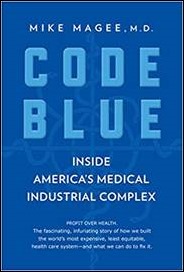News 6/14/19
Top News
Allscripts will buy specialty drug prescription prior authorization platform vendor ZappRx, according to reports, as it moves toward diversifying its EHR business.
The acquisition price was not disclosed, but is reportedly less than the $41 million ZappRx raised in seed, Series A, and Series B round from 2013 through 2017.
The acquisition will put other EHR vendors whose products use ZappRx in an interesting position – they will need to either remove the integration and force customers to go back to manual processes or pay the competitor who now owns the platform.

I interviewed ZappRx CEO Zoë Barry in November 2017. She explained why the inefficiency in specialty drug prescriptions had been overlooked until she formed ZappRx in 2012:
Specialty drugs are only 2 percent of the volume, about 70 million prescriptions total, although they make up about 40 percent of the drug spend. You need a very different software and product that handles specialty prescriptions and you need a very different business model for something that accommodates only 2 percent of the market.
Webinars
None scheduled soon. Previous webinars are on our YouTube channel. Contact Lorre for information.
Acquisitions, Funding, Business, and Stock

French company Dassault Systèmes will acquire clinical trials software vendor Medidata for $5.8 billion.

GE Ventures is reportedly looking for a buyer for its stake in 100-plus startups as parent company GE attempts a turnaround under a smothering $110 billion debt load and declining share price. Its active healthcare investments include Arcadia, Evidation Health, Iora Health, Omada Health, and Genome Medical.
Announcements and Implementations

Lewis County Health System (NY) goes live on Meditech.

Michigan physicians organization Answer Health deploys population health management technology from Lightbeam Health Solutions.

Community Health Network (IN) implements MModal’s real-time speech recognition, mobile documentation, virtual scribing, and transcription software.

Health Catalyst develops Population Health Foundations to help providers better analyze and understand clinical and financial performance.

Lawrence General Hospital (MA) goes live on Meditech Expanse.

Vocera incorporates AI and machine learning into the latest version of its mobile rounding app, and adds the Care Inform communication tool to its smartphone app.

Rush University Medical Center in Chicago transitions to Google Cloud with help from consulting firm Maven Wave, which also helped the hospital map unstructured EHR data to SNOMED codes.
Sales
- BMC HealthNet / Mercy Alliance will launch PatientWisdom’s digital member feedback platform to help it define the community health needs in Springfield, MA.
- Houston Methodist selects dose optimization software from Tabula Rasa HealthCare’s DoseMe subsidiary.
- Wake Radiology UNC Rex Healthcare will use Veriphyr’s patient data privacy monitoring to detect unauthorized access to medical records at its 14 locations in North Carolina.
People

Washington Health System (PA) promotes Rodney Louk to VP/COO. He will also continue in his CIO role.
Government and Politics

Secret recordings shared by a local news outlet in Australia reveal Queensland Health Director-General Michael Walsh’s opinion of the $1.5 billion Cerner IEMR project as “messy” and “not perfect.” He also admits to being required to publicly praise the project despite hearing end-user complaints about software glitches, costs, and skyrocketing stress levels. Thirteen hospitals have already gone live, and another 13 are scheduled to do so within the next two years.
Lawmakers express continued frustration with the lack of leadership over the VA and DoD’s EHR projects, calling the proposed Federal Electronic Health Record Modernization Program Office more of a concept than a concrete step towards joint governance. First proposed in March, FEHRM’s yet-to-be appointed director and deputy director will report jointly to deputy secretaries at the VA and DoD. Rep. Suzie Lee (D-NV), chair of the Subcommittee on Technology Modernization of the House Veterans Affairs Committee, didn’t hold back in her remarks on the bureaucratic foot-dragging:
For months this subcommittee has asked about a joint proposal to address longstanding problems with the existing [interagency program office]. There has been a name change, but we have seen nothing substantive. There is a one-page slide about a three-phase plan, but it is hard to find where the governance and accountability is in this plan. Based on the timeline for implementation it will come too late to address the critical decisions that need to be made now.
Privacy and Security
In China, police capture eight suspected hackers who used self-developed software to break into hospital registration systems and hijack appointment slots, which they then allegedly sold to the highest bidders.
Two people file a class action lawsuit claiming that Sutter Health is sharing patient medical information with Facebook, Google, and Twitter so those sites can target Internet advertising.
Other
The American Medical Association adopts a policy to support the education of physicians on the use of artificial intelligence in patient care.
An external review of University of Maryland Medical System finds that the health system issued no-bid contracts to companies of several members of its board, did not obtain full board approval for the deals, and pressured employees to use software sold by companies from which board members would benefit. Even the board’s financial auditor was caught assigning himself a no-bid deal. Baltimore’s mayor resigned after an investigation found that the health system spent hundreds of thousands of dollars on children’s book she wrote and four UMMS executives have resigned. Real Time Medical Systems founder and board member Scott Rifkin, MD says he provided analytics software to UMMS at no charge, but the review found that he tried to leverage the relationship to increase company sales and UMMS employees said they felt pressure to implement the software in skilled nursing facilities. The company raised $9.2 million in a February 2019 venture funding round.
Sponsor Updates

- ConnectiveRx team members spend the day helping Morris County Habitat for Humanity.
- Elsevier’s Via Oncology wins a MedTech Breakthrough Award for “Best Computerized Decision Support Solution.”
- EClinicalWorks will exhibit at the Northeast Regional Telehealth Conference June 17-18 in Portland, ME.
- Hayes Management Consulting names Elizabeth Lavelle content product owner.
- Healthfinch will host a focus group at the AMDIS Annual Physician-Computer Connection Symposium June 18-21 in Ojai, CA.
- InterSystems and Intelligent Medical Objects will exhibit at the AMDIS Annual Physician-Computer Connection Symposium June 18-21 in Ojai, CA.
- Kyruus will exhibit at the Patient Experience Transformation Assembly June 16-17 in Nashville.
- Information Builders will host seminars in Atlanta, Pittsburgh, St. Louis, and Herndon, VA to demonstrate the new features of its Omni-HealthData Provider Master Edition.
- KLAS recognizes Cumberland Consulting Group as a top-three consulting firm in its “2019 Payer Consulting IT” report.
- ZeOmega achieves full HISP P&S accreditation from EHNAC.
- Health Catalyst VP of Product Management Dan Soule joins the DirectTrust board.
Blog Posts
- Why Companies Should Consider Health IT Outsourcing (Dimensional Insight)
- A Fond Farewell to One of Ensocare’s Originals: Sherry Pickett (Ensocare)
- Silver Tsunami: “Never-Discharge” Mindset Helps People Age Safely at Home (Prepared Health)
- Goliath Technologies Delivers Unmatched Troubleshooting Capabilities in New Release (Goliath Technologies)
- 3 Signs You Need Refill Management Technology (Healthfinch)
- Care Manager Efficiency, Part 2: Leveraging Your Data (Healthwise)
- Healthcare IT: How Interoperability Makes Penetration Testing Even More Important (Fortified Health Security)
- What are the Top Initiatives of Huntzinger’s CTO? (Huntzinger Management Company)
- Information Builders Summit 2019 Recap (Information Builders)
- Our Journey Building a Safer, More Efficient Infusion System from the Ground Up (Ivenix)
- Point vs Platform Solutions in Healthcare Communications (Spok)
- ERP Shared Services Success Factors – Part 1 (Optimum Healthcare IT)
Contacts
Mr. H, Lorre, Jenn, Dr. Jayne.
Get HIStalk updates. Send news or rumors.
Contact us.


















































Merry Christmas and a Happy New Year to the HIStalk crowd. I wish you the joys of the season!